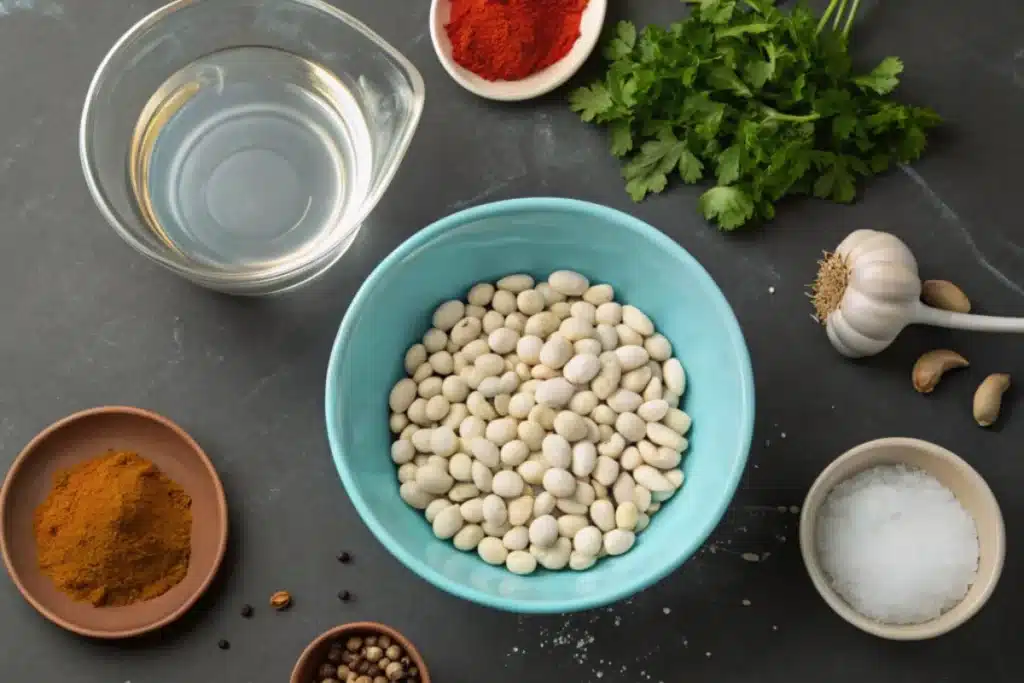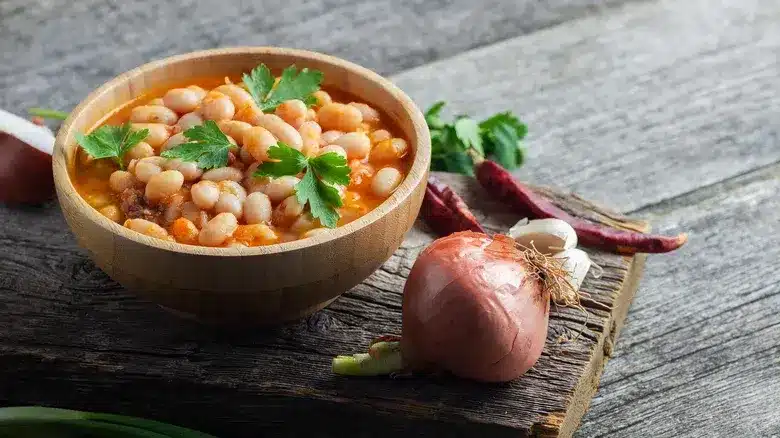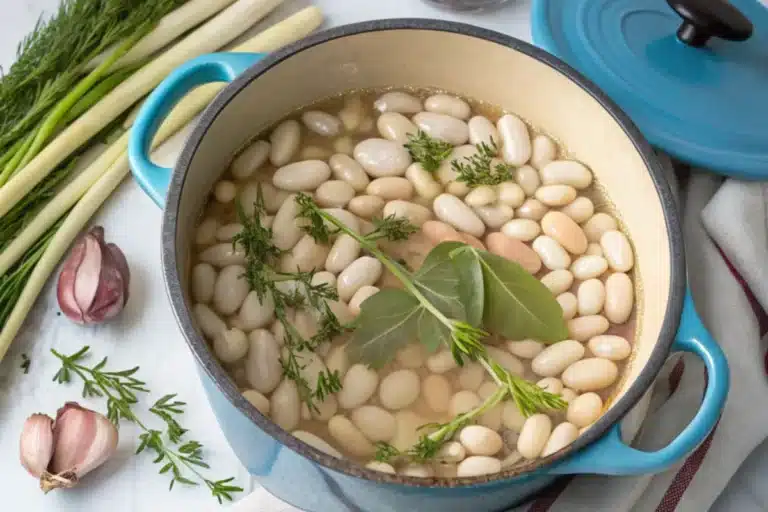Beans are a versatile, nutrient-packed ingredient loved worldwide. But when it comes to cooking them, the age-old question arises: why do we soak beans before stewing? This practice, often passed down through generations, is steeped in both science and tradition. In this article, we’ll discover the benefits, science, and techniques of soaking beans, all while debunking some common myths along the way. Let’s dive into the details, starting with the basics.
Table of Contents
Understanding the Basics of Bean Soaking
What Are Dry Beans and Why They Need Soaking
Dry beans, such as kidney beans, chickpeas, and black beans, are legumes that are harvested, dried, and stored. These pantry staples offer impressive longevity and nutritional value. However, their dried state makes them tough and requires a bit of prep work before cooking. Soaking helps rehydrate the beans, making them softer and easier to cook.
When dry beans are soaked, they absorb water, which loosens their tough outer skin and jumpstarts the cooking process. This not only saves time but also Secures a uniform texture when stewed.
Historical Practices Behind Soaking Beans for Stews
Soaking beans isn’t a modern kitchen hack—it’s an ancient practice. Cultures across the globe have used soaking to prepare beans for stews, soups, and other hearty meals. For example, traditional Mexican cuisine relies heavily on beans, and soaking has always been an essential first step to achieve the right consistency and flavor.
In some regions, soaking also served a practical purpose: it allowed cooks to inspect the beans, discarding any debris, stones, or bad seeds. While modern processing has reduced this need, soaking remains a vital culinary tradition rooted in both efficiency and taste.
The Science Behind Soaking Beans
How Soaking Changes the Composition of Beans
Soaking beans isn’t just about convenience—it’s a scientific process. When you immerse beans in water, they begin to absorb moisture, which softens their hard outer shell. This process breaks down complex carbohydrates, making the beans easier to digest. It also activates natural enzymes that help reduce the cooking time.
Water penetration triggers starch gelatinization, which improves the beans’ texture. Without soaking, beans may cook unevenly, leaving you with a mix of mushy and hard bites in your stew. So, the next time someone asks, “Why do we soak beans before stewing?”, the answer lies in both chemistry and practicality.
How Soaking Beans Removes Antinutrients
Many types of beans contain compounds like phytic acid and lectins, which are considered antinutrients. These substances can interfere with nutrient absorption in your body. Soaking helps neutralize these elements, making the beans not only tastier but also healthier.
For instance, red kidney beans contain a toxin called phytohemagglutinin. If not properly soaked and cooked, it can lead to digestive discomfort or worse. By soaking, you eliminate much of this risk, ensuring that your stews are safe and enjoyable.

Benefits Soak Beans Before Stewing?
Why Soaking Beans Improves Digestibility
One of the most significant benefits of soaking beans is improved digestibility. Beans are notorious for causing bloating and gas, primarily due to oligosaccharides—complex sugars that the human stomach struggles to break down. Soaking beans leaches out a portion of these sugars, making them gentler on your digestive system.
If you’ve ever hesitated to cook beans because of their reputation, know that soaking is your solution. Whether you’re making a hearty chili or a simple bean stew, this step makes a world of difference in how you—and your guests—feel after the meal.
How Soaking Shortens Cooking Time for Bean Stews
Soaking beans can cut down cooking time significantly, often by half. This isn’t just a time-saver—it’s also an energy-efficient approach. Less cooking time means you’ll use less gas or electricity, which is good for your wallet and the environment.
Furthermore, pre-soaked beans cook more evenly, ensuring a consistent texture throughout your dish. Imagine a stew with tender, creamy beans that melt in your mouth. Soaking sets the stage for this culinary perfection, answering the question of why do we soak beans before stewing with undeniable results.
Step-by-Step Guide to Why Do We Soak Beans Before Stewing?
Traditional Methods of Bean Soaking
For anyone wondering, “Why do we soak beans before stewing?”, it’s crucial to start with traditional soaking methods. The most common approach involves placing beans in a large bowl, covering them with water, and leaving them to soak overnight. This slow, hands-off method Secures the beans fully absorb water, making them softer and more uniform for cooking.
To Improve the soaking process, some cooks add a pinch of salt or a splash of vinegar. These additions can further reduce antinutrients and improve the flavor. Just be sure to rinse the beans thoroughly afterward to remove any residue.
Tips for Properly Timing and Storing Soaked Beans
Timing is everything when it comes to soaking beans. While overnight soaking (6–12 hours) works best, you can also use a quick-soak method if you’re short on time. To quick-soak, bring the beans and water to a boil for two minutes, then let them sit for an hour.
Once soaked, you should drain and rinse the beans before storing them. If you’re not cooking them immediately, place them in an airtight container and refrigerate them for up to three days. Proper storage prevents spoilage and Secures your beans are ready when you need them.
For a bean-based recipe, check out the Lemony Shrimp and Bean Stew on Masterly Recipes. It’s a perfect dish to showcase the benefits of soaking beans.

Common Myths About Soaking Beans
Debunking the Flavor Loss Myth
Some people avoid soaking beans, fearing it might leach out their flavor. However, this is a misconception. Soaking doesn’t wash away flavor—it simply removes unwanted compounds like dirt and excess starch. The flavor remains intact, especially if you cook the beans in a flavorful broth or stew.
In fact, soaking can Improve the taste by preventing the overpowering beaniness that sometimes occurs with unsoaked beans. This makes your stews more balanced and enjoyable.
Clarifying Nutritional Misconceptions
Another common myth is that soaking beans robs them of nutrients. While it’s true that some water-soluble vitamins may leach out, the nutritional loss is minimal. The benefits of improved digestibility and reduced antinutrients far outweigh this slight reduction.
For those still skeptical, consider the health advantages of soaking: easier digestion, better nutrient absorption, and a safer, toxin-free meal. It’s clear why the question, “Why do we soak beans before stewing?”, has such a compelling answer rooted in both science and taste.
FAQs
Do All Beans Need Soaking?
Not all beans require soaking, but it’s often recommended. Small varieties like lentils and split peas cook quickly without soaking. However, larger beans—like chickpeas and kidney beans—benefit from soaking, as it helps reduce their cooking time and Secures a consistent texture.
Still wondering, “Why do we soak beans before stewing?”? The answer varies based on the type of bean, but soaking generally improves the cooking process for most beans. If you’re ever in doubt, soaking is a safe bet for better results.
Can You Cook Beans Without Soaking?
Yes, it’s possible to cook beans without soaking, but it takes much longer. Cooking unsoaked beans often requires extra water and time, which can lead to unevenly cooked beans. The outer shell may soften before the center is fully cooked, creating an unpleasant texture.
For stews, unsoaked beans can also affect the overall consistency of the dish. So while skipping the soak is an option, soaking Secures a smoother, more flavorful result, making it clear why do we soak beans before stewing is such a popular kitchen question.
Alternative Methods to Prepare Beans Without Soaking
Pressure Cooking as a Substitute
If you’re in a hurry, a pressure cooker can save the day. Pressure cooking eliminates the need for soaking by rapidly softening beans, even in their dried state. This method is particularly useful when you need beans ready for a stew in under an hour.
However, while pressure cooking is convenient, it doesn’t reduce antinutrients like soaking does. If digestibility and nutrient absorption are priorities, soaking remains the superior method.
Quick Soaking Techniques for Busy Schedules
Short on time? Try a quick-soak method. Start by boiling the beans in water for two minutes, then turn off the heat and let them sit for about an hour. This technique hydrates the beans quickly and removes some of the same compounds that overnight soaking does.
Quick soaking is perfect for spontaneous meals or when you forget to soak beans overnight. It’s another way to answer the question, “Why do we soak beans before stewing?”, especially when time is tight but quality is still essential.
Common Mistakes When Soaking Beans
Using Too Little Water
One of the most frequent mistakes when soaking beans is not using enough water. Beans expand significantly as they absorb moisture, often doubling or tripling in size. If there isn’t enough water, the beans may not hydrate fully, leading to uneven cooking.
To avoid this, always use at least three times as much water as beans. For instance, if you’re soaking one cup of beans, add three to four cups of water. This simple precaution Secures your beans are well-soaked and ready for stewing, answering why do we soak beans before stewing with practical results.
Forgetting to Rinse the Beans
After soaking, it’s crucial to drain and rinse the beans thoroughly. This step removes the starches and compounds that were released during soaking. Skipping this step can lead to off-flavors in your stew and negate some of the digestibility benefits.
Rinsing also Secures you’re cooking with clean, fresh beans, free of any residues or impurities. It’s an easy step but one that makes a big difference in both flavor and texture.
Final Thoughts on Soaking Beans
Why Soaking Beans Is Worth the Effort
Soaking beans is a small step that makes a big difference in your cooking. It may feel unnecessary, especially with modern tools like pressure cookers, but the benefits are undeniable. When you soak beans, you’re preparing them to cook evenly, develop a tender texture, and blend Smoothly into your dishes. This consistency is especially important when making stews, where every ingredient plays a crucial role in flavor and balance.
Moreover, soaking beans can save you time in the long run. By reducing cooking time by nearly half, it helps you whip up meals faster and with less energy. This isn’t just good for your schedule; it’s also better for your utility bills and the environment. For anyone asking, “Why do we soak beans before stewing?”, these practical benefits are reason enough.
Additionally, soaking is a chance to add subtle layers of flavor to your beans. You can experiment by soaking them in broth, a splash of vinegar, or even a squeeze of citrus. These small touches can Improve the flavor profile of your stew, elevating it from simple to extraordinary.
Adapting the Process to Your Routine
In today’s busy world, it’s easy to skip steps in the kitchen, but soaking beans doesn’t have to be time-consuming. Plan ahead by setting up a soak the night before or use a quick-soak method if you’re in a rush. While traditional overnight soaking provides the most benefits, quick soaking is a reliable alternative for getting similar results when time is short.
You can also soak beans in large batches to save time for future meals. Once soaked, beans can be stored in the fridge for a few days or even frozen for months. This flexibility Secures you always have prepped beans ready for a hearty stew or soup.
Finally, soaking offers health benefits that shouldn’t be overlooked. By reducing antinutrients, soaking improves nutrient absorption, making your meals not only tastier but also healthier. It’s a win-win for anyone who loves wholesome, home-cooked food.
Building Confidence in Cooking with Beans
For new cooks, soaking beans can seem intimidating, but it’s one of the simplest kitchen techniques to master. All it takes is water, a bit of time, and a little planning. As you get comfortable with the process, you’ll see how it Improves your stews, soups, and other bean-based dishes.
The next time you’re preparing a recipe and find yourself wondering, “Why do we soak beans before stewing?”, remember that soaking is an essential step for better texture, taste, and overall quality. It’s a time-honored tradition that continues to make sense, even in today’s fast-paced kitchens.


